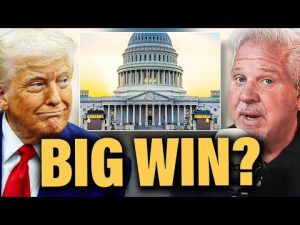**Trump Takes a Stand: Uncovering the Truth About South Africa’s “Kill the Boer” Chant**
In a surprising turn of events, former President Donald Trump made headlines during a visit from South African President Cyril Ramaphosa. This was no ordinary diplomatic meeting; Trump, as the leader of the free world, decided to address a controversial issue head-on. With the flair that only he could manage, President Trump took the opportunity to shed light on the alarming rhetoric surrounding violence against white farmers in South Africa. Instead of classic diplomatic small talk, he dazzled everyone by sharing some rather shocking video evidence, turning an otherwise routine meeting into a candid discussion about serious accusations.
As President Trump dimmed the lights and hit play, viewers were treated to footage of a South African political leader chanting phrases that sent chills down many spines, including cries to “kill the Boer.” The footage depicted a disturbing scene—thousands of people cheering on such violence. The crowd was large, and the implications were even bigger. By showcasing this content, Trump wasn’t merely stirring the pot; he was raising a crucial conversation that media outlets, such as CNN, seemed eager to ignore or downplay.
The reaction from the media was, unsurprisingly, mixed. Critics quickly labeled Trump’s assertions as overblown, and some suggested historical context was needed before jumping to conclusions. In this divide, it seemed as though many chose to overlook the real-life consequences of the chants and the disturbing trend of violence in South Africa’s countryside. With reports stating that many white farmers have been murdered recently, questions arose about how far folks would go to dismiss these claims before acknowledging an urgent problem.
Now, one might wonder about the potential motives behind bringing such a sensitive topic to the forefront. Some theorists argue that this discussion might be part of a larger narrative concerning race relations and land ownership in South Africa. Given the historical backdrop of apartheid, it’s no surprise that tensions still run high. However, the alarming reality is that the violence against white farmers cannot continue to be swept under the rug, no matter the historical disagreements. How many more must suffer before there is substantial action?
Trump’s approach raised eyebrows, as he insisted on holding Ramaphosa accountable. He presented data and even a file that highlighted the very real threats facing white farmers, and it made the South African president squirm a bit in his seat. With the sheer audacity of it all, Trump created a visual and verbal showdown that echoed conversations often silenced in mainstream media. If nothing else, it was sheer entertainment: A dramatic dinner theater featuring politics at its finest, complete with a dash of controversy.
As the dust settled after the meeting, one couldn’t help but wonder what the future holds for South Africa and its ongoing issues. In this age of information and misinformation, it’s imperative to have honest dialogues about such serious matters. President Trump may have just tossed a spark into a much-needed debate. Whether it ignites a wildfire of change or fizzles out remains to be seen. But at least for now, thanks to Trump’s boldness, the conversation about “killing the Boer” isn’t going anywhere anytime soon.







